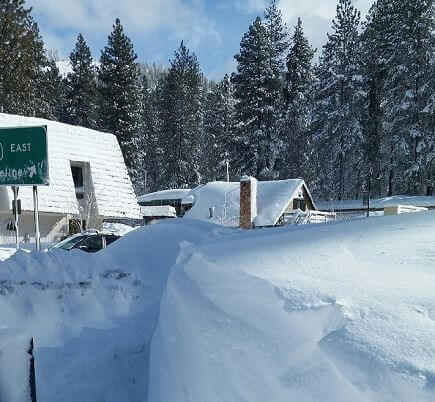Placer’s Sierra residents and businesses reminded to clear propane tanks
With the potential for snow buildup on buildings and systems, Placer County public safety agencies are advising Placer’s Sierra residents and businesses to monitor buildings, propane tanks and natural gas lines for signs of excessive loading due to heavy snow.
Residents and businesses should monitor roof vents, chimneys and flues for blockage due to snow buildup. These systems need unobstructed access to outside air to properly ventilate. Blockages can lead to carbon monoxide buildup in buildings, creating a potentially unsafe interior environment. The heavy snow may also cause chimneys to shift, creating potential falling or fire hazards.
Particular attention should be paid to buildings constructed before Placer County adopted snow-load standards in the High Sierra areas in the early 1960s. While construction standards since that time considered average snow accumulation, exceptional snow accumulation may exceed design limits, creating a potential risk.
“It is best to have a qualified professional inspect potential propane and natural gas leaks,” said Chief Building Official Tim Wegner.
Local agencies are reminding residents and businesses to properly care for propane tanks and gas lines because deep snowpack can damage pipes, valves and tanks leading to leaks.
Anyone who smells propane or natural gas inside or outside a building should call 911 immediately. They also should avoid smoking, starting engines or motors, turning on cooking appliances, using heating-air conditioning systems or using other ignition sources.

Potential heavy snow danger signs include:
- Visual deformation or sagging of beams and other parts of a building’s structural support system.
- Newly-developed cracks, particularly any that appear above windows or doors and where beams and other support structures are located. Minor cracks that expand or contract could be indications of building movement.
- Doors and windows that suddenly become significantly harder to open or do not open at all, a sign that a building may be settling.
- Water leaks inside buildings.
- Recent buckling of interior or exterior siding and finishes, which may be a symptom of settling.
- Sprinkler heads being pushed down below ceiling levels.
If there is any doubt about the integrity of a roof in such extreme snow conditions then the building or area should be evacuated until professional advice can be sought.
Generally, residents and business owners are not encouraged to try to clear roofs when the snow load becomes very heavy. Potential dangers include:
- Injuries caused by falling snow.
- Roof damage caused by removing snow from some areas, but leaving heavy snow loads in others. Unbalanced unloading of the snow can create unstable conditions and potential building collapse.
- Electrical hazards from overhead power lines and electrical service drops that are no longer visible or too close to the walking surface.
Residents and business owners concerned about the snow loads on roofs are encouraged to seek the advice of California-licensed roofing and general contractors or California-registered engineers.
For homes at elevations above 5,000 feet, residents and businesses with propane questions should contact either their propane suppliers or local fire agencies. For natural gas questions, contact suppliers or California-licensed plumbing and mechanical contractors.
Safety tips for the proper care of propane tanks during severe weather and advice for natural gas users to follow when they smell gas are available at here.
It is recommended that property owners and managers keep contact information, including home and cell phone numbers, current with gas suppliers, homeowner associations and neighbors. In a gas emergency, it is important that emergency personnel be able to contact affected property owners.
Operating generators during power outages and alternative heating can also create problems if not used properly. When using portable generators, keep them outdoors and far away from open doors, windows and vents to avoid toxic levels of carbon monoxide from building up indoors.




